Medical Physics Report: Radiation Health Risks and Precautions
VerifiedAdded on 2022/08/21
|6
|949
|16
Report
AI Summary
This medical physics report examines the health consequences of both ionizing and non-ionizing radiation technologies. It defines these types of radiation, differentiating between their ability to ionize atoms and molecules, and discusses the sources of each, including UV radiation from the sun and man-made sources like X-rays. The report details the adverse health effects associated with exposure to both types of radiation, such as burns, retinal damage, skin rashes, and potential for brain injury in fetuses. It outlines key precautions and safety measures, including the use of protective equipment, limiting exposure time, increasing distance from radiation sources, and employing barriers. The role of the Health and Safety Executive (HSE) in monitoring and controlling radiation-related activities is also addressed. The report references several studies and guidelines from organizations like WHO and ICNIRP.
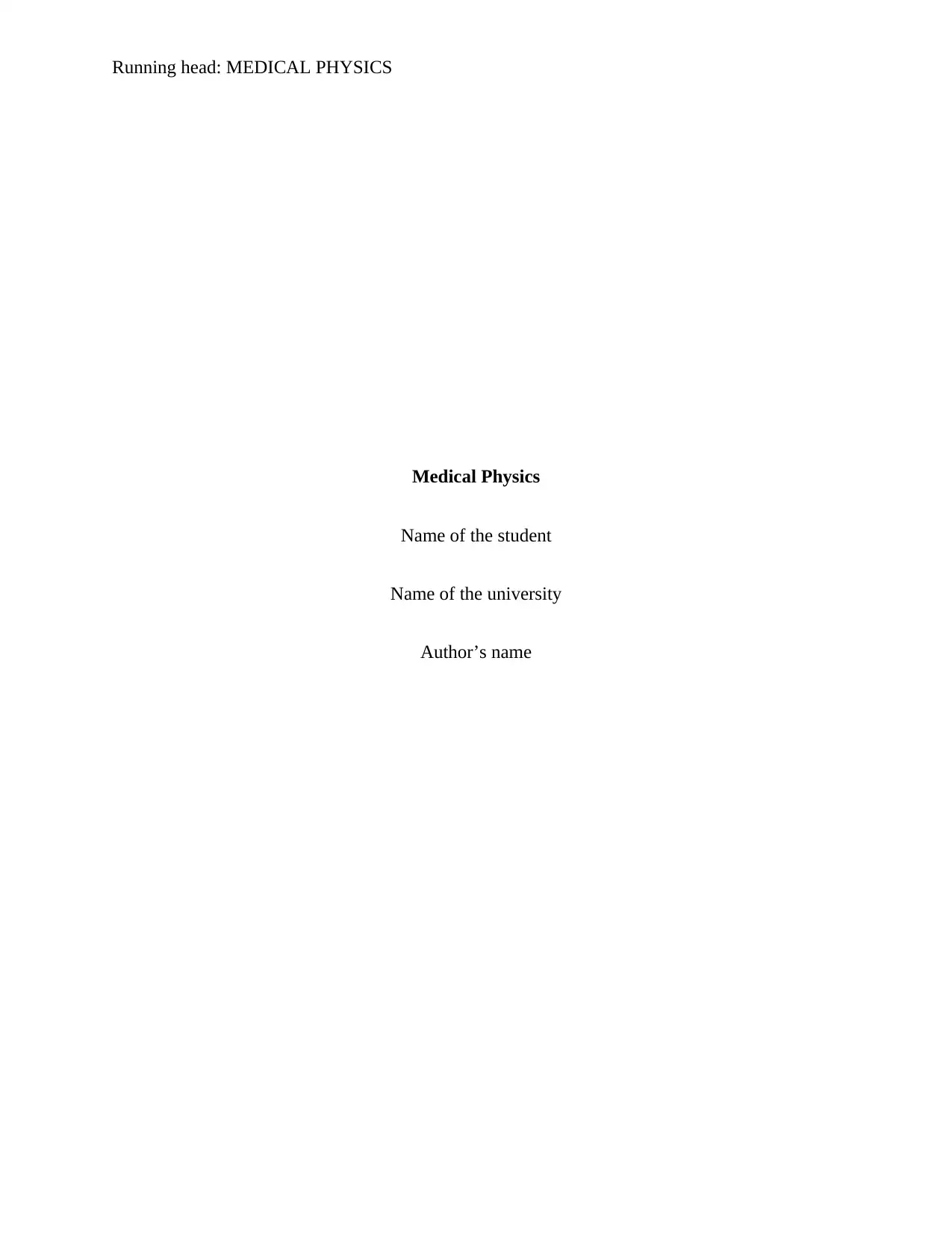
Running head: MEDICAL PHYSICS
Medical Physics
Name of the student
Name of the university
Author’s name
Medical Physics
Name of the student
Name of the university
Author’s name
Paraphrase This Document
Need a fresh take? Get an instant paraphrase of this document with our AI Paraphraser
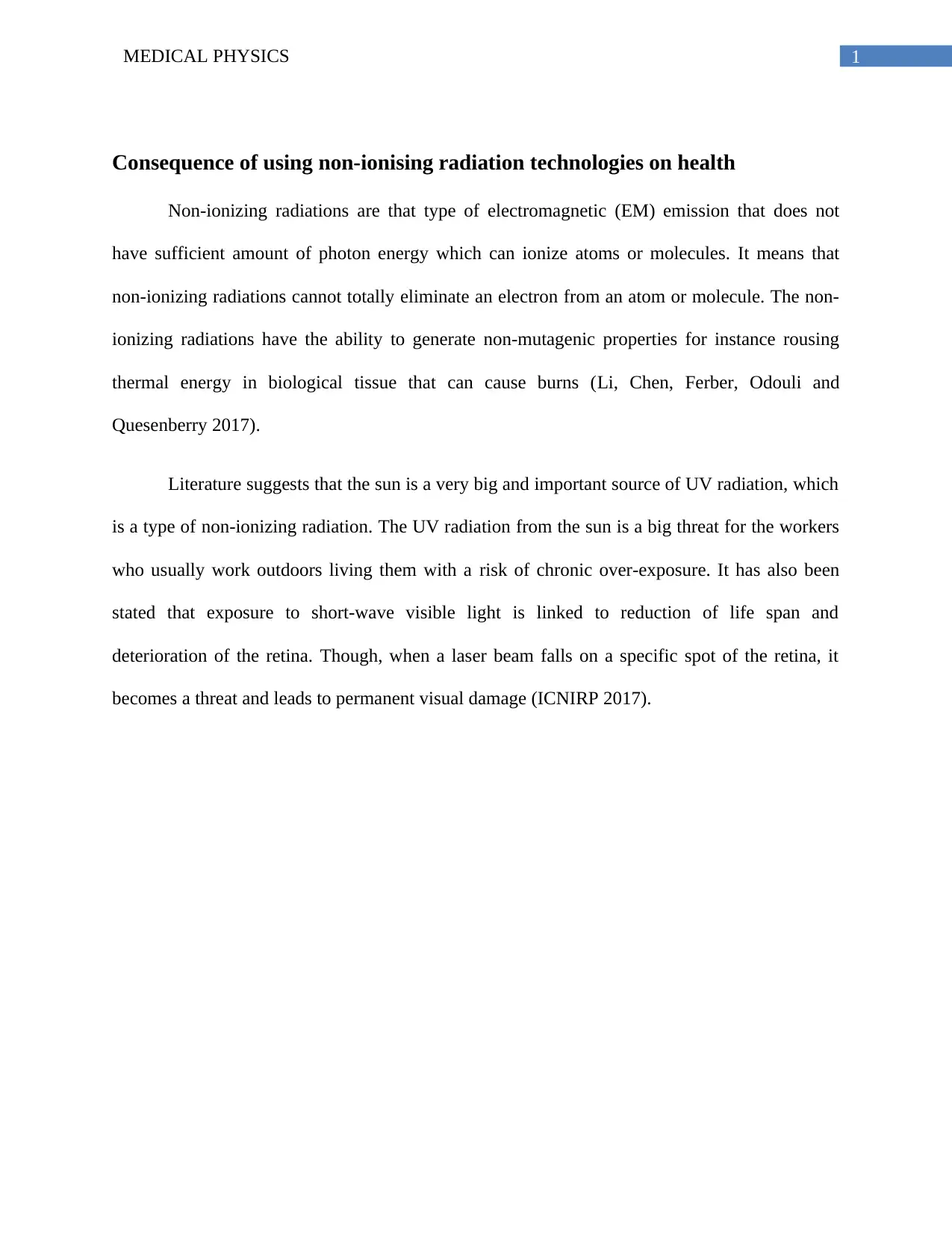
1MEDICAL PHYSICS
Consequence of using non-ionising radiation technologies on health
Non-ionizing radiations are that type of electromagnetic (EM) emission that does not
have sufficient amount of photon energy which can ionize atoms or molecules. It means that
non-ionizing radiations cannot totally eliminate an electron from an atom or molecule. The non-
ionizing radiations have the ability to generate non-mutagenic properties for instance rousing
thermal energy in biological tissue that can cause burns (Li, Chen, Ferber, Odouli and
Quesenberry 2017).
Literature suggests that the sun is a very big and important source of UV radiation, which
is a type of non-ionizing radiation. The UV radiation from the sun is a big threat for the workers
who usually work outdoors living them with a risk of chronic over-exposure. It has also been
stated that exposure to short-wave visible light is linked to reduction of life span and
deterioration of the retina. Though, when a laser beam falls on a specific spot of the retina, it
becomes a threat and leads to permanent visual damage (ICNIRP 2017).
Consequence of using non-ionising radiation technologies on health
Non-ionizing radiations are that type of electromagnetic (EM) emission that does not
have sufficient amount of photon energy which can ionize atoms or molecules. It means that
non-ionizing radiations cannot totally eliminate an electron from an atom or molecule. The non-
ionizing radiations have the ability to generate non-mutagenic properties for instance rousing
thermal energy in biological tissue that can cause burns (Li, Chen, Ferber, Odouli and
Quesenberry 2017).
Literature suggests that the sun is a very big and important source of UV radiation, which
is a type of non-ionizing radiation. The UV radiation from the sun is a big threat for the workers
who usually work outdoors living them with a risk of chronic over-exposure. It has also been
stated that exposure to short-wave visible light is linked to reduction of life span and
deterioration of the retina. Though, when a laser beam falls on a specific spot of the retina, it
becomes a threat and leads to permanent visual damage (ICNIRP 2017).
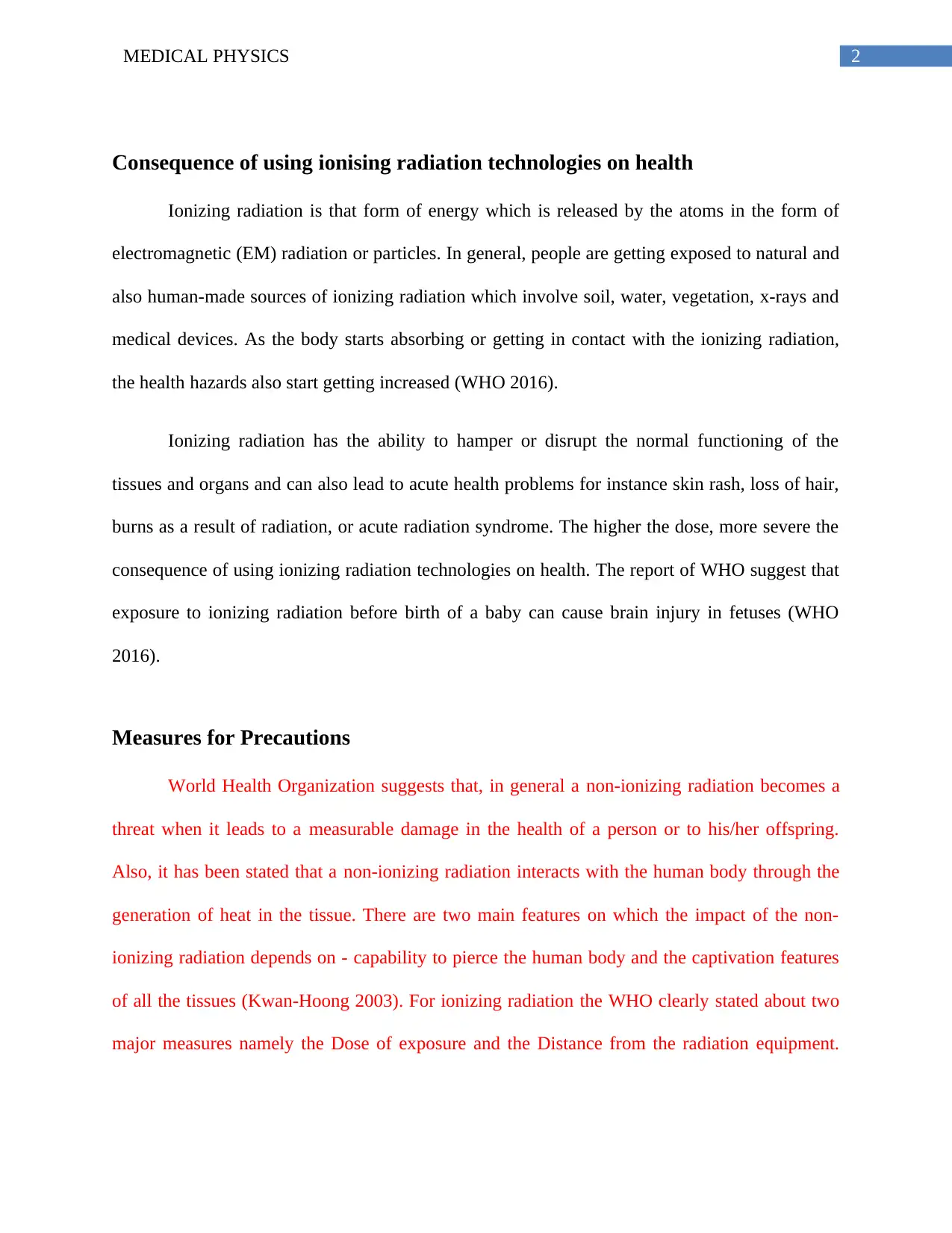
2MEDICAL PHYSICS
Consequence of using ionising radiation technologies on health
Ionizing radiation is that form of energy which is released by the atoms in the form of
electromagnetic (EM) radiation or particles. In general, people are getting exposed to natural and
also human-made sources of ionizing radiation which involve soil, water, vegetation, x-rays and
medical devices. As the body starts absorbing or getting in contact with the ionizing radiation,
the health hazards also start getting increased (WHO 2016).
Ionizing radiation has the ability to hamper or disrupt the normal functioning of the
tissues and organs and can also lead to acute health problems for instance skin rash, loss of hair,
burns as a result of radiation, or acute radiation syndrome. The higher the dose, more severe the
consequence of using ionizing radiation technologies on health. The report of WHO suggest that
exposure to ionizing radiation before birth of a baby can cause brain injury in fetuses (WHO
2016).
Measures for Precautions
World Health Organization suggests that, in general a non-ionizing radiation becomes a
threat when it leads to a measurable damage in the health of a person or to his/her offspring.
Also, it has been stated that a non-ionizing radiation interacts with the human body through the
generation of heat in the tissue. There are two main features on which the impact of the non-
ionizing radiation depends on - capability to pierce the human body and the captivation features
of all the tissues (Kwan-Hoong 2003). For ionizing radiation the WHO clearly stated about two
major measures namely the Dose of exposure and the Distance from the radiation equipment.
Consequence of using ionising radiation technologies on health
Ionizing radiation is that form of energy which is released by the atoms in the form of
electromagnetic (EM) radiation or particles. In general, people are getting exposed to natural and
also human-made sources of ionizing radiation which involve soil, water, vegetation, x-rays and
medical devices. As the body starts absorbing or getting in contact with the ionizing radiation,
the health hazards also start getting increased (WHO 2016).
Ionizing radiation has the ability to hamper or disrupt the normal functioning of the
tissues and organs and can also lead to acute health problems for instance skin rash, loss of hair,
burns as a result of radiation, or acute radiation syndrome. The higher the dose, more severe the
consequence of using ionizing radiation technologies on health. The report of WHO suggest that
exposure to ionizing radiation before birth of a baby can cause brain injury in fetuses (WHO
2016).
Measures for Precautions
World Health Organization suggests that, in general a non-ionizing radiation becomes a
threat when it leads to a measurable damage in the health of a person or to his/her offspring.
Also, it has been stated that a non-ionizing radiation interacts with the human body through the
generation of heat in the tissue. There are two main features on which the impact of the non-
ionizing radiation depends on - capability to pierce the human body and the captivation features
of all the tissues (Kwan-Hoong 2003). For ionizing radiation the WHO clearly stated about two
major measures namely the Dose of exposure and the Distance from the radiation equipment.
⊘ This is a preview!⊘
Do you want full access?
Subscribe today to unlock all pages.

Trusted by 1+ million students worldwide
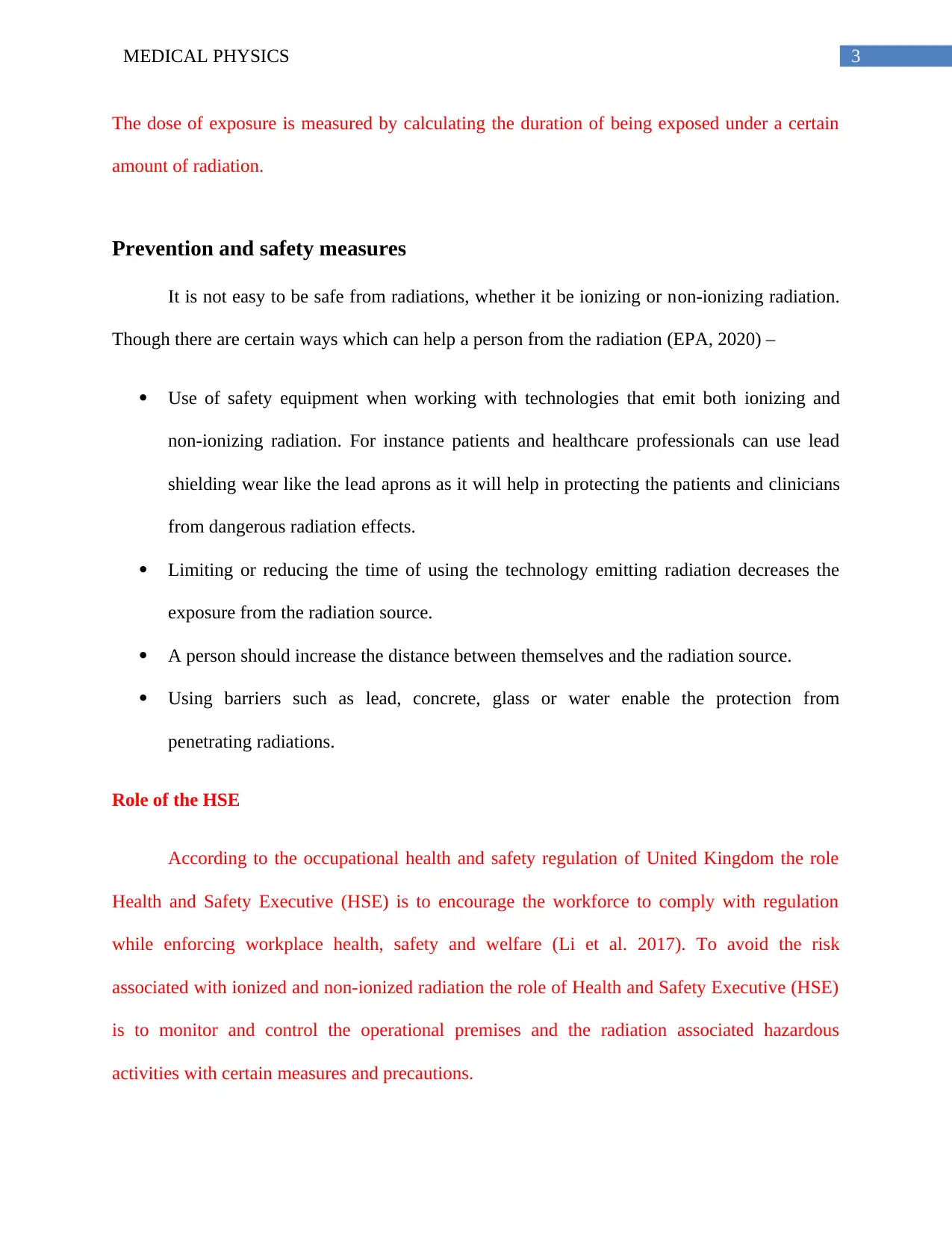
3MEDICAL PHYSICS
The dose of exposure is measured by calculating the duration of being exposed under a certain
amount of radiation.
Prevention and safety measures
It is not easy to be safe from radiations, whether it be ionizing or non-ionizing radiation.
Though there are certain ways which can help a person from the radiation (EPA, 2020) –
Use of safety equipment when working with technologies that emit both ionizing and
non-ionizing radiation. For instance patients and healthcare professionals can use lead
shielding wear like the lead aprons as it will help in protecting the patients and clinicians
from dangerous radiation effects.
Limiting or reducing the time of using the technology emitting radiation decreases the
exposure from the radiation source.
A person should increase the distance between themselves and the radiation source.
Using barriers such as lead, concrete, glass or water enable the protection from
penetrating radiations.
Role of the HSE
According to the occupational health and safety regulation of United Kingdom the role
Health and Safety Executive (HSE) is to encourage the workforce to comply with regulation
while enforcing workplace health, safety and welfare (Li et al. 2017). To avoid the risk
associated with ionized and non-ionized radiation the role of Health and Safety Executive (HSE)
is to monitor and control the operational premises and the radiation associated hazardous
activities with certain measures and precautions.
The dose of exposure is measured by calculating the duration of being exposed under a certain
amount of radiation.
Prevention and safety measures
It is not easy to be safe from radiations, whether it be ionizing or non-ionizing radiation.
Though there are certain ways which can help a person from the radiation (EPA, 2020) –
Use of safety equipment when working with technologies that emit both ionizing and
non-ionizing radiation. For instance patients and healthcare professionals can use lead
shielding wear like the lead aprons as it will help in protecting the patients and clinicians
from dangerous radiation effects.
Limiting or reducing the time of using the technology emitting radiation decreases the
exposure from the radiation source.
A person should increase the distance between themselves and the radiation source.
Using barriers such as lead, concrete, glass or water enable the protection from
penetrating radiations.
Role of the HSE
According to the occupational health and safety regulation of United Kingdom the role
Health and Safety Executive (HSE) is to encourage the workforce to comply with regulation
while enforcing workplace health, safety and welfare (Li et al. 2017). To avoid the risk
associated with ionized and non-ionized radiation the role of Health and Safety Executive (HSE)
is to monitor and control the operational premises and the radiation associated hazardous
activities with certain measures and precautions.
Paraphrase This Document
Need a fresh take? Get an instant paraphrase of this document with our AI Paraphraser

4MEDICAL PHYSICS
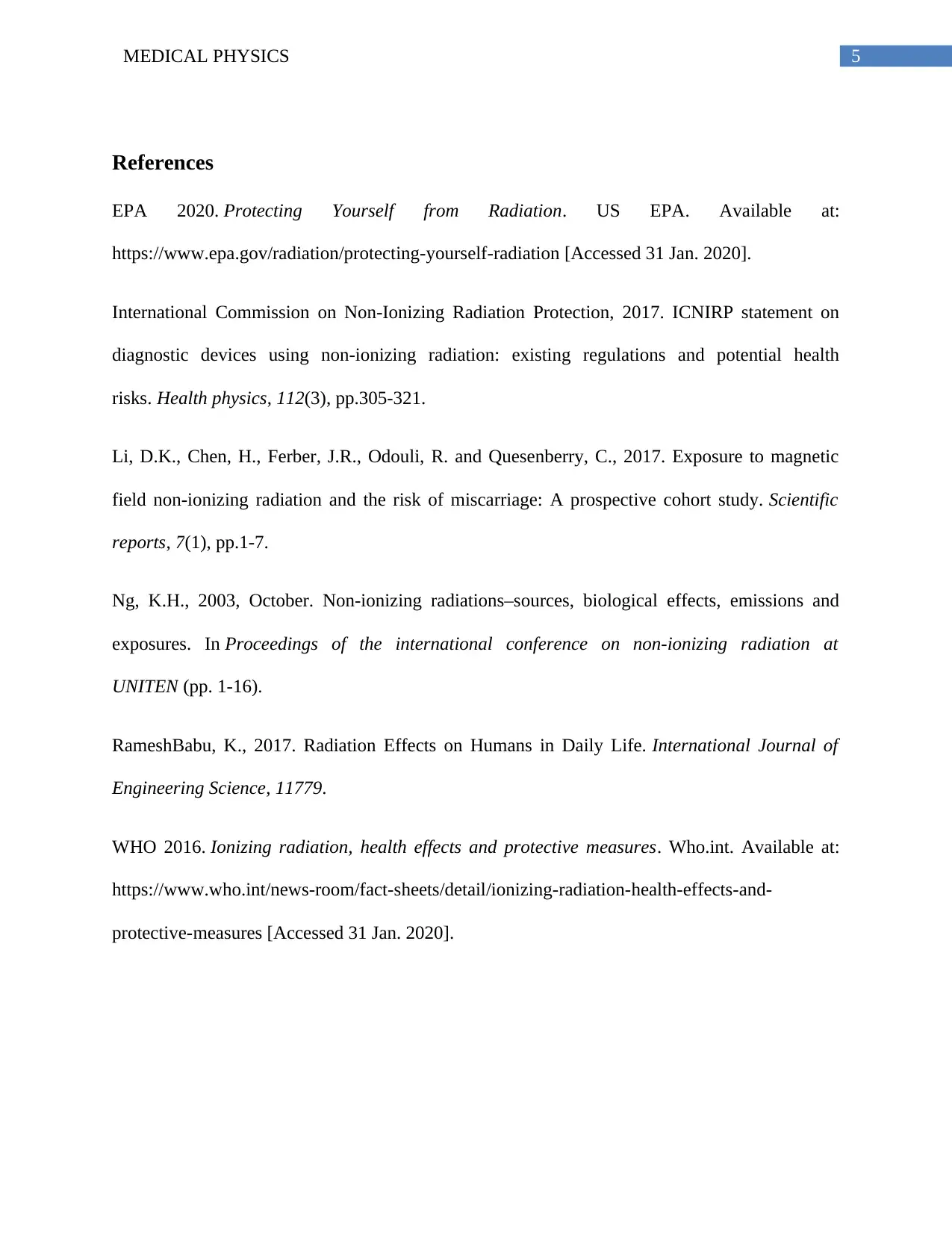
5MEDICAL PHYSICS
References
EPA 2020. Protecting Yourself from Radiation. US EPA. Available at:
https://www.epa.gov/radiation/protecting-yourself-radiation [Accessed 31 Jan. 2020].
International Commission on Non-Ionizing Radiation Protection, 2017. ICNIRP statement on
diagnostic devices using non-ionizing radiation: existing regulations and potential health
risks. Health physics, 112(3), pp.305-321.
Li, D.K., Chen, H., Ferber, J.R., Odouli, R. and Quesenberry, C., 2017. Exposure to magnetic
field non-ionizing radiation and the risk of miscarriage: A prospective cohort study. Scientific
reports, 7(1), pp.1-7.
Ng, K.H., 2003, October. Non-ionizing radiations–sources, biological effects, emissions and
exposures. In Proceedings of the international conference on non-ionizing radiation at
UNITEN (pp. 1-16).
RameshBabu, K., 2017. Radiation Effects on Humans in Daily Life. International Journal of
Engineering Science, 11779.
WHO 2016. Ionizing radiation, health effects and protective measures. Who.int. Available at:
https://www.who.int/news-room/fact-sheets/detail/ionizing-radiation-health-effects-and-
protective-measures [Accessed 31 Jan. 2020].
References
EPA 2020. Protecting Yourself from Radiation. US EPA. Available at:
https://www.epa.gov/radiation/protecting-yourself-radiation [Accessed 31 Jan. 2020].
International Commission on Non-Ionizing Radiation Protection, 2017. ICNIRP statement on
diagnostic devices using non-ionizing radiation: existing regulations and potential health
risks. Health physics, 112(3), pp.305-321.
Li, D.K., Chen, H., Ferber, J.R., Odouli, R. and Quesenberry, C., 2017. Exposure to magnetic
field non-ionizing radiation and the risk of miscarriage: A prospective cohort study. Scientific
reports, 7(1), pp.1-7.
Ng, K.H., 2003, October. Non-ionizing radiations–sources, biological effects, emissions and
exposures. In Proceedings of the international conference on non-ionizing radiation at
UNITEN (pp. 1-16).
RameshBabu, K., 2017. Radiation Effects on Humans in Daily Life. International Journal of
Engineering Science, 11779.
WHO 2016. Ionizing radiation, health effects and protective measures. Who.int. Available at:
https://www.who.int/news-room/fact-sheets/detail/ionizing-radiation-health-effects-and-
protective-measures [Accessed 31 Jan. 2020].
⊘ This is a preview!⊘
Do you want full access?
Subscribe today to unlock all pages.

Trusted by 1+ million students worldwide
1 out of 6
Your All-in-One AI-Powered Toolkit for Academic Success.
+13062052269
info@desklib.com
Available 24*7 on WhatsApp / Email
![[object Object]](/_next/static/media/star-bottom.7253800d.svg)
Unlock your academic potential
Copyright © 2020–2025 A2Z Services. All Rights Reserved. Developed and managed by ZUCOL.


